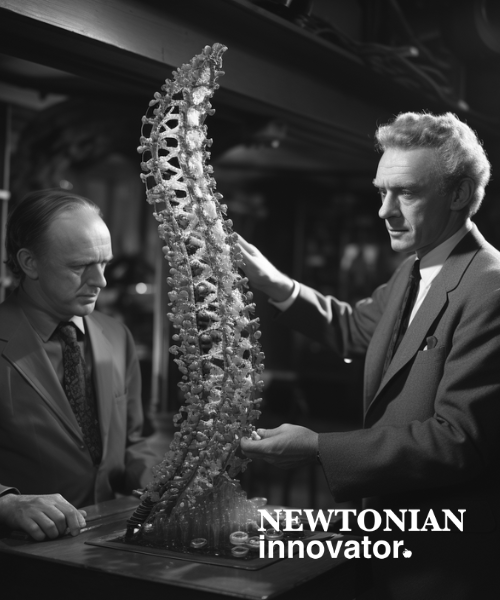In 1953, James Watson and Francis Crick stunned the scientific world when they discovered the double helix structure of DNA. This groundbreaking discovery was made possible not just through experimental data, but also from thought experiments used by the researchers. Crick in particular was a strong proponent of visualizing structures in his mind’s eye to gain new insights. Though they relied heavily on X-ray crystallography data collected by Rosalind Franklin, Watson and Crick used imaginative thinking and mental modeling to put the pieces together.
James Watson was born on April 6, 1928 in Chicago, Illinois. He became fascinated with bird-watching as a child, which sparked his interest in science and nature. Watson went on to earn his Ph.D. in zoology from Indiana University in 1950, where he studied the effects of X-rays on viruses. He then conducted postdoctoral research at the University of Copenhagen for a year before moving to the Cavendish Laboratory at Cambridge University. There, Watson met Francis Crick and they began studying the structure of DNA.
Francis Crick was born on June 8, 1916 in Northampton, England. He studied physics at University College London, where he graduated with a Bachelor of Science degree in 1937. During World War II, Crick worked as a scientist for the Admiralty researching the design of magnetic and acoustic mines. After the war, he began studying biology and earned his Ph.D. in 1954 from Cambridge University, where he and James Watson. Crick made significant contributions to the study of consciousness and theoretical neuroscience. He was known for his clever wit and push for visualizing abstract scientific ideas. Crick died in 2004 at the age of 88.

Rosalind Franklin was born in 1920 in London, England. She earned a Ph.D. in physical chemistry from Cambridge University. Franklin used X-ray diffraction techniques to capture excellent images of DNA which were pivotal to Watson and Crick’s discovery of its double helix structure. Though not credited at the time, her work was central to unraveling DNA’s molecular makeup. Franklin died of ovarian cancer in 1958 at just 37 years old.
The thought experiment approach was central to Crick and Watson’s discovery of the structure of DNA. Watson and Crick’s thought experimentation was centered around envisioning potential molecular configurations of DNA. They knew DNA was composed of four nucleotides – adenine, thymine, cytosine, and guanine. The question was, how were these nucleotides bonding together to form the structure of DNA?
By leveraging X-ray diffraction images captured by Franklin, Watson and Crick were able to visualize DNA’s molecular components through mental modeling and conceptualization. Specifically, they visualized different potential configurations of DNA’s molecular structure. With so little physical data available at the time, thought experiments allowed them to create options for how the nucleotides could bond together into a spine with branching sides to conclude that DNA was comprised of two helical chains coiled together. By iterating through mental models, they landed on the now iconic twisted ladder shape of DNA. The double helix arose in their minds before they had full experimental verification. The power of thought experiments was central to their deductive reasoning processes that uncovered the secret of life.
In their minds, they twisted the nucleotides into pairs, trying out different shapes and strand orientations. After testing many imaginary configurations, they landed on nucleotides binding in complementary pairs – adenine with thymine and cytosine with guanine. Visualizing this pairing allowed each strand of the helix to serve as a template for the other.
They mentally sculpted the sugar-phosphate backbones into antiparallel chains on the outside of the molecule. This positioning allowed the complementary bases to face inward towards each other. The entire double helix structure began taking shape in their thoughts.
Watson and Crick continued refining their mental model by picturing hydrogen bonds between the nucleotide pairs holding the two strands together. They also theorized the strands separating during replication, this was a key feature of their proposed structure.
These thought experiments required tremendous visualization abilities and logical reasoning. Each new mental modification brought them closer and closer to DNA’s actual physical form. The mysteries of genetics were being solved in their scientifically fertile imaginations.
After arriving at their final imagined model, Watson and Crick had a “AHA!” moment. Their thought experiment pointed strongly to the now iconic double helix structure. While they still needed experimental verification, they were confident enough to publish their proposed model in a 1953 paper proposing the double helix structure. The publication sent shockwaves through the scientific community and fundamentally transformed Crick and Watson’s careers overnight. They went from relatively unknown researchers to scientific celebrities credited with unraveling the mystery of life’s genetic code. The thought experiment gave them a crucial edge over competitors also studying DNA at the time. In later years, Crick continued using thought experiments to make advances in neuroscience. The thoughtful creativity exemplified through their work on DNA set Crick and Watson on paths to becoming two of the most famous scientists of the 20th century.
In the end, the thought experiment approach was the critical ingredient that allowed Watson, Crick, and Franklin to decipher DNA’s double helix structure. When data alone proved insufficient, their ability to theorize creative molecular models led to Watson sharing the 1962 Nobel Prize in Physiology or Medicine with Crick and Maurice Wilkins.

Thought experiments will continue enabling scientific advances into the future. By envisioning potential new structures and dynamics, scientists can provide solutions to even the most confounding mysteries. With openness to building conceptual models, thought experiments can guide the way when experimental techniques have reached their limits.
As we stand on the precipice of new scientific frontiers, the legacy of Watson, Crick, and Franklin serves as inspiration for researchers worldwide. Their visionary approach to science, rooted in the power of imagination and educated visualization, unlocked the secrets of life’s genetic code. Today, as we struggle with mysteries like dark energy, negative energy, or the intricacies of quantum mechanics, we must remember the power of the mind’s eye. We may not yet have the tools to directly measure or observe these phenomena, but by harnessing the power of thought experiments, we can begin to conceptualize their nature.
The universe is vast, and its mysteries are many. Yet, the human mind, with its boundless capacity for creativity and imagination, remains our most effective tool. Just as Watson and Crick visualized the double helix before its experimental verification, today’s researchers can pave the way for tomorrow’s discoveries by daring to envision the unseen.
To the scientists and researchers of today, embrace the legacy of those who came before. Harness the power of visualization, and let your educated imaginations roam free. For in the interplay of data and dreams, the next groundbreaking discovery awaits.
In a world where the boundaries of knowledge are ever-expanding, may we always remember that the limits of our imagination are only set by ourselves. Let us look to the past, to the visionary minds like Watson, Crick, and Franklin, and be inspired to forge ahead, turning the imagined into the known. The unraveling of DNA’s structure will stand forever as one of the great triumphs of disciplined creativity and imagination in science.






